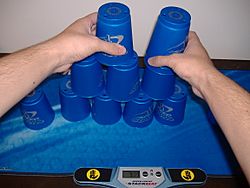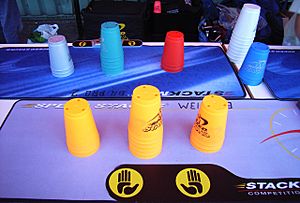Sport stacking facts for kids

A 1-10-1 being upstacked as part of the cycle stack
|
|
| Highest governing body | World Sport Stacking Association |
|---|---|
| Nicknames | Cup stacking, speed stacking |
| First played | 1981, Oceanside, California, U.S. |
| Registered players | 618,394 (number of worldwide participants in the Guinness World Record set in 2015) |
| Characteristics | |
| Contact | No |
| Team members | Individual, doubles, teams of 4 or 5 |
| Mixed-sex | Yes, but in separate divisions |
| Type | Indoor, Outdoor |
| Equipment | Cups, mat, timer |
| Presence | |
| Country or region | Worldwide |
| Olympic | AAU Junior Olympic Games |
Sport stacking, also known as cup stacking or speed stacking, is an individual and team sport that involves stacking 9 or 12 (usually 12) specially designed cups in pre-determined sequences as fast as possible. The cups are specially designed to allow for speedier times. Participants of sport stacking stack cups in specific sequences, by aligning the inside left lateral adjunct of each cup with that of the next. Sequences are usually pyramids of 3, 6, or 10 cups. Players compete against the clock or another player.
The governing body setting the rule is the World Sport Stacking Association (WSSA).
Contents
Equipment
Official sport stacking cups are specially designed to prevent sticking and to allow the competitor to go faster. The cups are reinforced with several ribs on the inside which separate the cups when they are nestled. The exterior is slightly textured to allow better grip. The insides are very smooth and slide past each other easily. The tops of the cups have 1-4 holes to allow ventilation so the cups do not stick. One special line of cups has cups without tops to further decrease air resistance.
StackMat timers are used for official tournament timing, as well as casual play timing or practice timing.
Special weighted training cups, called "Super Stacks," are made from metal and are most commonly used directly before competing. The added weight is intended to make the regular cups feel lighter.
Jumbo Stacks are a bigger version of the original speed stacks cups. They are used more commonly in P.E. classes rather than at home.
Rules
There are three sequences stacked in official sport stacking events, that are defined by the rule book handed out by the WSSA:
- 3-3-3: Uses nine cups. This sequence consists of three sets of three cups each. The three sets must be stacked going from left-to-right or right-to-left, and then down-stacked into their original positions in the same order as the up-stack.
- 3-6-3: Uses 12 cups. This sequence is similar to the 3-3-3, except a six stack replaces the three stack in the middle. Each pile of cups is stacked up from left-to-right or right-to-left, and the down-stack occurs in the same order.
- Cycle: Uses 12 cups. This sequence involves a 3-6-6 which is then down-stacked and then going into a 6-6 stack which is down-stacked again and finally stacked into a 1-10-1 and all down-stacked back into how it started
Benefits
Proponents of the sport say participants learn cooperation, ambidexterity and hand–eye coordination.
A university study by Brian Udermann, currently at the University of Wisconsin-Lacrosse, confirms that stacking improves hand–eye coordination & reaction time by up to 30% (published in the scientific Journal "Perceptual and Motor Skills" in 2004)
An EEG-study by Melanie A. Hart, Ph.D. Assistant Professor Department of Health, Exercise and Sports Sciences at the Texas Tech University support the claim that cup stacking does utilize both sides of the brain. During the left-hand condition, activity in the right hemisphere was larger than the left, while for the right-hand task, the left hemisphere was greater than the right. Their scientific poster on that topic got awarded by the AAHPERD On the other hand, Hart couldn't get the same results as Udermann when studying improvement on reaction time.
Gibbons, E., Hendrick, J. L., & Bauer, J. State University of New York studied the effects on the reaction time and confirmed Udermann rather than Hart, stating "that the results agreed with the claims made by Speed Stacks, in which practicing cup stacking can improve reaction time. They also state "Even 1 hour of cup stacking practice can improve reaction time in young adults." Speed stacking was also seen as helping people improve in other sports because it helps to improve the hand-eye coordination.
The Department of Kinesiology at Towson University studied the influence of participation in a 6-week bimanual coordination program on Grade 5 students' reading achievement with Sports Stacking being the bimanual activity. In a pilot study, a significant increase was found for the experimental group on comprehension skills, suggesting that Sports Stacking may improve students' reading comprehension skills, regardless of sex.
In 2007 Cupstacking was tested in a study at the University of Nevada-Las Vegas investigating learning as a pair and the advantages of practising together concluding that observation was of greater importance than conversation in learning from a partner. These results are not restricted to Cupstacking alone but reflect the scientific acceptance of the sport
Competition
Most sport stacking competitions are geared toward children. There are also divisions for "Special Stackers" (disabled competitors).
The WSSA has set the following protocol for the setting of world records:
- Must use WSSA-approved sport stacking cups.
- Must use a StackMat and tournament display.
- Must be videotaped for review and verification purposes.
- Must use 2 judges (one designated Head Judge) to judge each try. After each try, the 2 judges confer. The head judge will then designate with a color-coded card the outcome of that try. (Green-clean run, yellow-try in question (immediate video review) & red–scratch.)
- A finals judge may not be a family member or the sport stacking instructor of the stacker.
The competition's divided into 14 different age divisions, ranging from 6 & under to seniors (65 & up). State, national & world records are recorded on the WSSA website.
World records
Male
| Event | Time | Stacker |
|---|---|---|
| 3-3-3 | 1.322 | |
| 3-6-3 | 1.658 | |
| Cycle | 4.753 |
Female
| Event | Time | Stacker |
|---|---|---|
| 3-3-3 | 1.424 | |
| 3-6-3 | 1.770 | |
| Cycle | 5.042 |
Combined
| Event | Time | Stackers |
|---|---|---|
| Doubles | 5.798 | |
| 3-6-3 Relay | 12.187 | Pro Series E |



